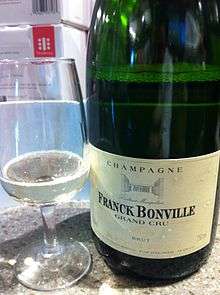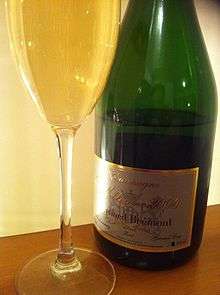Cru (wine)
Cru is "a vineyard or group of vineyards, especially one of recognized quality".[1] It is a French wine term which is traditionally translated as "growth", as it was originally the past participle of the verb "croître" (to grow). As a wine term it is closely connected to terroir in the sense of an "extent of terrain having a certain physical homogeneity . . . considered from the point of view of the nature of the soil as communicating a particular character to its produce, notably to wine".[2] It may thus be defined as: "Terroir as a place of production"[3] or an "Ensemble of terrains considered from the point of view of what grows there, from a particular cultivation."[4] More specifically, cru is often used to indicate a specifically named and legally defined vineyard or ensemble of vineyards and the vines "which grow on [such] a reputed terroir; by extension of good quality."[4] The term is also used to refer to the wine produced from such vines. The term cru is often used within classifications of French wine. By implication, a wine that displays (or is allowed to display) the name of its cru on its wine label is supposed to exhibit the typical characteristics of this cru. The terms Premier Cru, Grand Cru, etc., are generally translated into English as First Growth, Great Growth, etc.; they designate levels of presumed quality that are variously defined in different wine regions.

Premier cru
Premier cru is a French language wine term corresponding to "First Growth", and which can be used to refer to classified vineyards, wineries and wines, with different meanings in different wine regions:[5]
- For Bordeaux wine, the term is applied to classified wineries:
- In the Bordeaux Wine Official Classification of 1855, Premier cru or Premier cru classé is the highest level of five within the "Grand cru classé" designation for red wines from the Médoc and Graves, and the second-highest of three in Sauternes where the highest is Premier Cru Supérieur (superior first growth). These wines are often referred to as First Growths in English.
- In the Classification of Saint-Émilion wine, the highest level is Premier grand cru classé A and the second-highest Premier grand cru classé B. The term Saint-Émilion Grand cru refers to wineries or wines below the overall Grand cru classé level, and is integrated within the appellation rules.
- For Burgundy wine, the term is applied to classified vineyards, with Premier cru being the second-highest classification level, below that of Grand cru and above the basic village AOCs. For Burgundy wines, the terms Premier Cru or 1er Cru are usually kept rather than being translated into English.
Grand cru

Grand cru (French for 'great growth'[6]) is a regional wine classification that designates a vineyard known for its favorable reputation in producing wine. Although often used to describe grapes, wine or cognac, the term is not technically a classification of wine quality per se, but is intended to indicate the potential of the vineyard or terroir. It is the highest level of classification of Appellation d'origine contrôlée (AOC) wines from Burgundy or Alsace. The same term is applied to Châteaux in Saint-Émilion, although in that region it has a different meaning and does not represent the top tier of classification. In Burgundy the level immediately below grand cru is known as premier cru, sometimes written as 1er cru.[7]
History in Burgundy
Early Burgundian wine history is distinctly marked by the work of the Cistercians with the Catholic Church being the principal vineyard owner for most of the Middle Ages. Receiving land and vineyards as tithes, endowments and as exchanges for indulgences the monks were able to studiously observe the quality of wines from individual plots and over time began to isolate those areas that would consistently produce wine of similar aroma, body, color and vigor and designate them as crus.[8]
Following the success of the Bordeaux Wine Official Classification of 1855, Jules Lavalle developed an informal classification of vineyards of the Côte d'Or in his book History and Statistics of the Côte d'Or. In 1861, Lavalle's classification was formalized by the Beaune Committee of Agriculture.[9] The designations of grand cru and premier cru were later developed and expanded on in the 1930s with the creation of the AOC system.[10]
See also
References
- "cru - definition of cru in English - Oxford Dictionaries".
- "TERROIR : Définition de TERROIR".
- "CRU1 : Définition de CRU1".
- "CRU : Définition de CRU".
- J. Robinson (ed.). The Oxford Companion to Wine, Third Edition. p. 544. Oxford University Press, 2006. ISBN 0-19-860990-6.
- "grand cru" at Oxford Dictionaries
- J. Robinson (ed.). The Oxford Companion to Wine, Third Edition. p. 321. Oxford University Press, 2006. ISBN 0-19-860990-6.
- H. Johnson. Vintage: The Story of Wine. p. 131. Simon and Schuster, 1989. ISBN 0-671-68702-6.
- J. Robinson (ed.). The Oxford Companion to Wine, Third Edition. p. 175. Oxford University Press, 2006. ISBN 0-19-860990-6.
- J. Robinson (ed.). The Oxford Companion to Wine, Third Edition. p. 115. Oxford University Press, 2006. ISBN 0-19-860990-6.